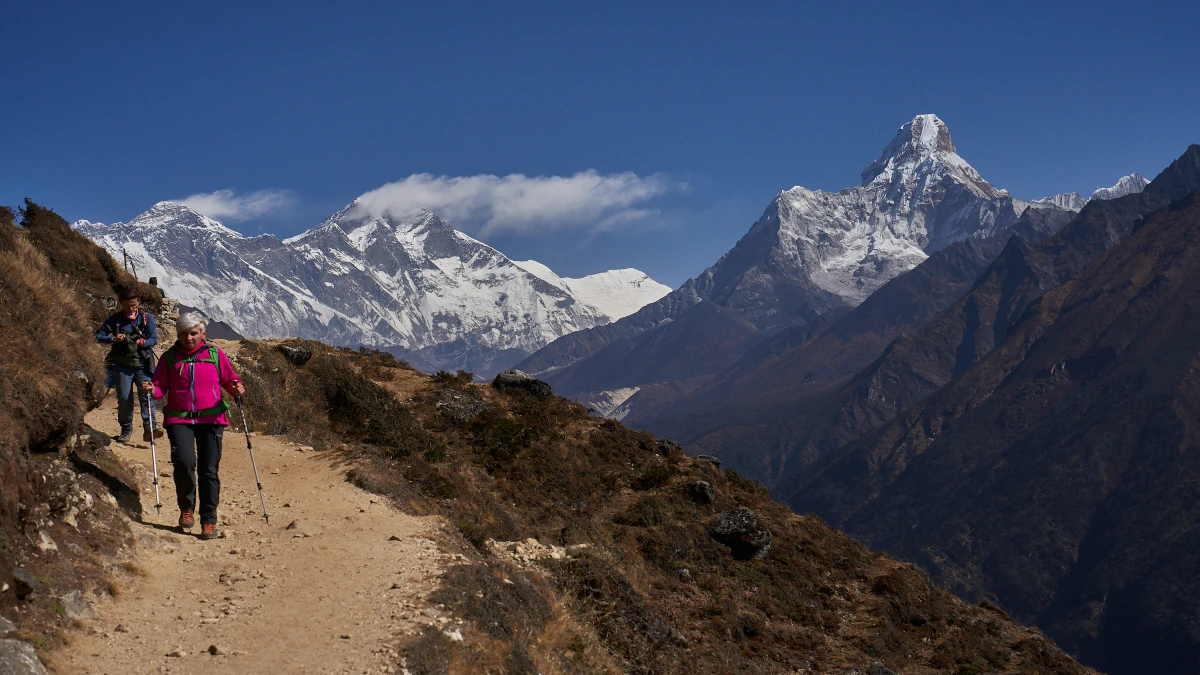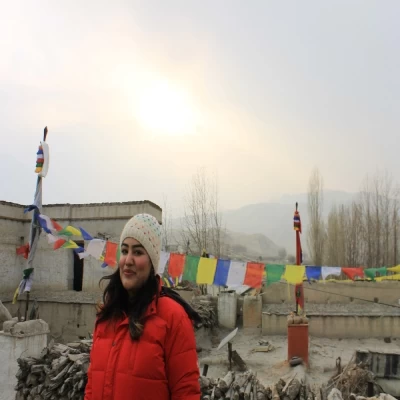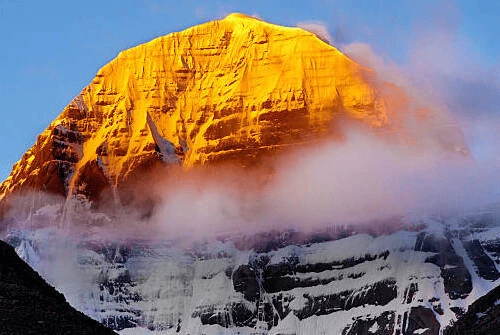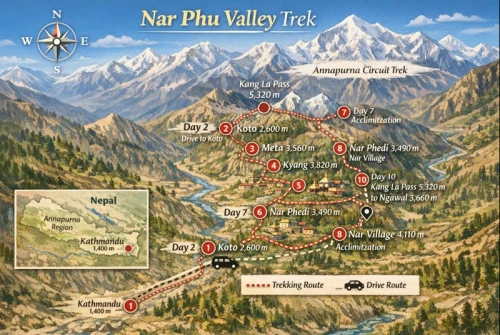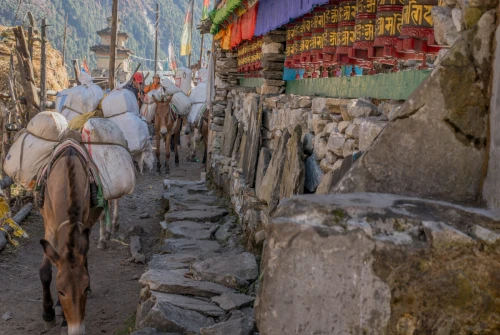Overview
Have you already booked your Everest Base Camp (EBC) trek? Bags packed, boots ready, and excitement running high? Perfect. But before you head off to one of the greatest adventures of your life, let’s get real for a moment, this trek is not just about stunning Himalayan views and bragging rights. The EBC trek is physically and mentally demanding, and even the most prepared trekkers often wish they knew a few hidden tips before setting foot on the trail.
Most guides and blogs tell you the obvious, train before you go, pack warm clothes, choose the right season. That’s useful, sure. But once your ticket is booked and your dates are locked in, that kind of advice is no longer helpful. What you need now are insider hacks, small but powerful tips, and on-the-ground wisdom that can make the difference between an exhausting struggle and a smooth, enjoyable journey.
Think about it this way: trekking to EBC is not just about walking; it’s about how you handle the altitude, how you take care of your body day after day, how you interact with locals, and even how you manage your nights in cold tea houses. Little details, like knowing how to wash clothes at 4,000 meters, how to order food wisely, or when exactly to charge your devices, can save you energy, money, and frustration.
So, here are 10 unique and practical tips for Everest Base Camp trek, designed specifically for those who already have their trek booked and are ready to go. These are the things seasoned trekkers wish they had known earlier—advice you won’t always find in typical blogs or travel brochures.
1. Don’t Rely on the Menu, Order Dal Bhat Like a Local
Every tea house on the EBC trek will hand you a menu full of tempting options: pasta, pizza, even fried noodles. Sounds comforting, right? The problem is, most of these meals are made with ingredients carried up from lower altitudes or flown into Lukla. Freshness, hygiene, and nutrition can vary, and honestly, nothing fuels you like a good plate of Dal Bhat, the Nepali staple of rice, lentil soup, vegetables, and pickles.
Why Dal Bhat?
- Unlimited refills – In many tea houses, you can get extra rice and lentils at no extra cost.
- Easier digestion – Unlike heavy Western dishes, Dal Bhat is designed for energy and recovery.
- Supports locals – This is what Sherpas themselves eat daily for strength.
Here’s the insider tip: Don’t experiment with new dishes at higher altitudes. Stick with Dal Bhat or simple soups in the upper regions (above Namche Bazaar). Your stomach will thank you, and you’ll avoid food-related sickness that could ruin your trek.
2. Carry a Power Bank, but Charge It Wisely
Electricity in the Everest region is a luxury. Tea houses charge you anywhere from $2–$5 per device to plug into their solar-powered outlets. And at higher altitudes, the price goes up as power becomes scarcer.
Instead of constantly paying for charging, bring a high-capacity power bank (20,000–30,000 mAh). But here’s the trick:
- Charge during the day when the sun is strong – Solar panels generate better power in midday, so ask tea house owners to charge your bank while you trek.
- Switch your phone to airplane mode – There’s almost no network beyond Namche, so don’t waste battery searching for signals.
- Keep power banks warm – Cold drains batteries fast. Wrap them in your sleeping bag at night.
Few trekkers realize how valuable electricity is in the Himalayas until they’re stranded with dead devices and no cash left to pay for charging.
3. Learn the “Tea House Etiquette” Before You Go
Staying in tea houses is part of the charm of the EBC trek. But many first-time trekkers unknowingly break unspoken rules, which can cause awkward moments with locals.
Key etiquette tips:
- Eat where you sleep – If you stay in a tea house, it’s expected that you’ll also order dinner and breakfast there. Don’t sleep in one place and eat elsewhere.
- Don’t waste food – Everything has been carried up by porters and yaks. Order only what you can finish.
- Mind the dining stove – The central stove in the dining room is for everyone. Don’t hog it by spreading clothes or gear around it.
- Quiet hours matter – Most trekkers go to bed early. Respect the silence after 9 p.m.
Following these customs not only shows respect but also ensures you get warmer service (and sometimes extra perks like better blankets).
4. Master the Art of Layering (Because Laundry Is a Nightmare)
Here’s something most blogs won’t tell you: doing laundry above Namche Bazaar is nearly impossible. The water is freezing, drying clothes takes days, and you won’t want to waste your energy scrubbing socks in icy conditions.
Instead, master the art of layering and smart clothing rotation:
- Base layers (3 sets) – Rotate daily and sleep in the cleanest set.
- Mid-layers (2 fleeces) – One for trekking, one for evenings.
- Outer down jacket – Save it for evenings and high-altitude camps.
- Extra underwear & socks – More important than extra T-shirts.
Pro hack: Pack a few lightweight, quick-dry wet wipes. A quick wipe-down at the end of the day can feel like a shower when real showers are too cold or too expensive to attempt.
5. Keep Small Bills, Cash Is King in the Himalayas
By the time you reach Namche Bazaar, ATMs become unreliable, and digital payments are non-existent. Everything, charging, Wi-Fi, hot showers, extra blankets, costs extra, and prices double as you go higher.
Always carry plenty of small bills (100 and 500 Nepali rupees). Tea house owners often don’t have change for large notes, and you don’t want to waste time bargaining when you’re tired and cold.
Here’s a golden tip: budget at least $30–$40 per day in cash, in addition to what you’ve prepaid for accommodation and guides. This ensures you never run short when you need something extra, like a hot thermos of tea on a freezing night.
6. Hydration Strategy: Don’t Just Drink, Drink Smart
At high altitudes, your body loses water faster through breathing and exertion, yet many trekkers underestimate hydration. The common advice is to drink 3–4 liters daily, but it’s not just about quantity, it’s about how and when you drink.
Insider hydration hacks:
- Sip, don’t gulp – Constant small sips are more effective than chugging liters at once, which can upset your stomach.
- Warm water > cold water – Cold water slows digestion at altitude. Carry a thermos if possible.
- Add electrolytes – Pack hydration tablets or oral rehydration salts. They help replace lost minerals and prevent fatigue.
- Flavor packets – Simple juice powder can make plain boiled water more palatable after days of the same taste.
Another little-known tip: start your day with 500ml of water before breakfast. It jumpstarts hydration and makes trekking much easier. Many trekkers skip this because mornings are freezing, but warm water or tea makes a big difference.
7. Carry a “High-Altitude First Aid Kit” Beyond the Basics
Most trekkers bring painkillers and band-aids, but at EBC, you need a more specialized set of supplies. Altitude, cold, and long days create unique challenges.
What to include (beyond standard meds):
- Diamox (acetazolamide) – Helps with acclimatization. Take only if prescribed.
- Blister care kit – Compeed or moleskin patches are lifesavers.
- Rehydration salts – To fight dehydration from diarrhea or overexertion.
- Cold & cough meds – A simple cough can get worse in the dry Himalayan air.
- Water purification tablets or SteriPen – Safer than relying on bottled water.
A unique trick many seasoned trekkers swear by: vaseline or petroleum jelly for your nose and lips. The dry, dusty trails combined with cold air can cause painful cracks that make every breath miserable.
8. Start Early, Not Just for the Views but for Safety
You’ll notice locals and experienced guides always prefer to start trekking early—sometimes as early as 6 or 7 a.m. It’s not just tradition; there’s strategy behind it.
Benefits of early starts:
- Better weather – Afternoons often bring clouds, wind, or even snow. Mornings are calmer and clearer.
- Avoid crowds – Popular trails like Namche to Tengboche can get jammed later in the day.
- Time to rest – Finishing early gives you more recovery time at tea houses.
- Emergency buffer – If you’re delayed due to weather, fatigue, or health issues, you still have daylight left.
Insider advice: use a headlamp and leave just before sunrise on key days (like the hike to Kala Patthar). Watching the first light hit Everest is not just magical, it’s something most late starters miss.
9. Mental Endurance Matters More Than Physical Fitness
You might be in top physical shape, but altitude doesn’t care. What gets most trekkers through the toughest days is mental strength. There will be moments when the air feels too thin, your legs too heavy, or the cold too sharp. That’s when mindset takes over.
Practical mental hacks:
- Break the trek into chunks – Don’t think about 7 hours of walking. Think about “just 20 minutes to the next rest stop.”
- Mantras or breathing rhythms – Sherpas often hum or chant softly. You can adopt your own rhythm to pace your steps.
- Celebrate small wins – Every village, every ridge, every viewpoint is progress.
- Detach from expectations – The trail isn’t a race. Going slow is the real strength at high altitude.
A unique perspective: treat the trek as meditation. The slow rhythm of walking, the silence of the mountains, and the deep breathing naturally calm your mind, if you allow it.
10. Recovery Rituals: Take Care of Your Body Every Night
The biggest mistake trekkers make? They walk all day, collapse in a tea house, and skip recovery. But at high altitude, your body needs deliberate care to keep going strong.
Nightly recovery rituals to adopt:
- Stretch before bed – Focus on calves, hamstrings, and shoulders. Prevents stiffness the next morning.
- Warm up your sleeping bag – Put a hot water bottle inside for cozy, uninterrupted sleep.
- Foot care – Massage your feet with moisturizer or Vaseline. It prevents blisters and cracking.
- Mindful breathing – Five minutes of deep breathing helps oxygen flow and calms your nervous system.
- Protein snack – A boiled egg, nuts, or chocolate before bed aids recovery when meals are carb-heavy.
One unique hack: elevate your feet on your backpack while lying down. It reduces swelling from long days of trekking and improves blood circulation.
Conclusion
The Everest Base Camp trek is less about brute strength and more about smart preparation, patience, and respect for the mountains. Once you’ve booked your trip, the details matter more than ever, the food you eat, how you hydrate, when you walk, how you recover, and even how you interact with locals. Following these often-overlooked tips can transform your trek from a constant struggle into a rewarding adventure where you truly enjoy every step of the journey.
Remember, the mountain doesn’t demand perfection, it asks for humility, consistency, and awareness. Take care of your body, respect Sherpa traditions, and let the Himalayas teach you patience and resilience.
FAQs
1. Should I take Diamox before symptoms of altitude sickness appear?
It depends. Some trekkers take it preventively; others only if symptoms occur. Always consult your doctor before trekking.
2. How much money should I carry for the Everest Base Camp trek?
Budget at least $30–$40 per day in cash for extras like charging, showers, and Wi-Fi, in addition to prepaid costs.
3. Do I need trekking poles for EBC?
Yes. They reduce strain on your knees and provide balance on steep descents.
4. Is Wi-Fi available on the trail?
Yes, via the “Everest Link” card system. However, it’s expensive and often slow. Use sparingly.
5. How do I stay motivated when I feel exhausted?
Break the trek into small goals, walk slowly, and remember—it’s not a race. Even the slowest trekker can reach Base Camp with the right mindset.
